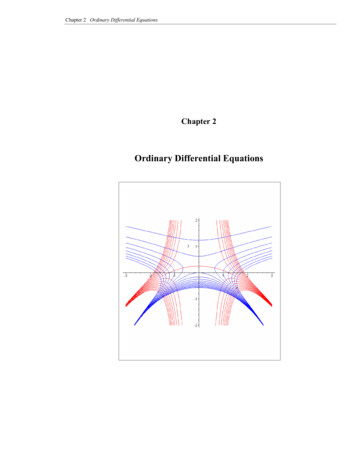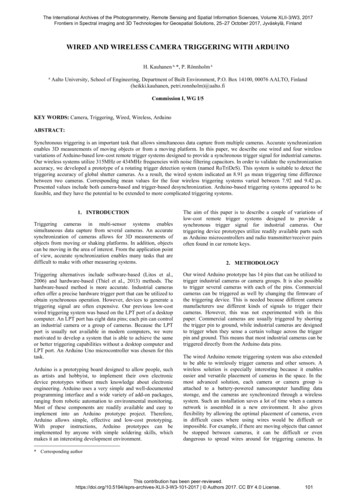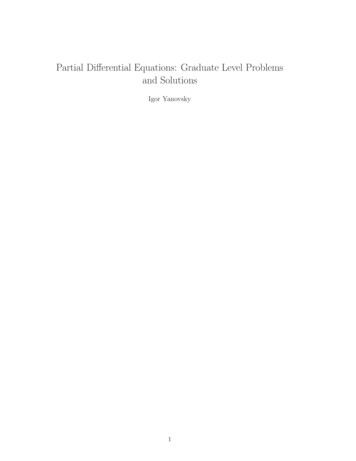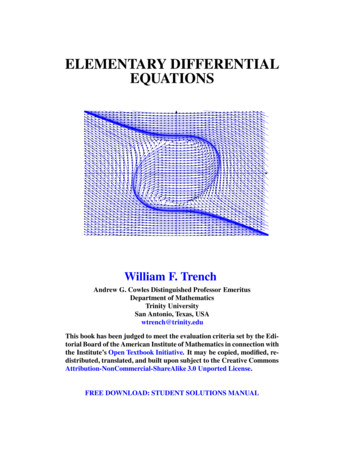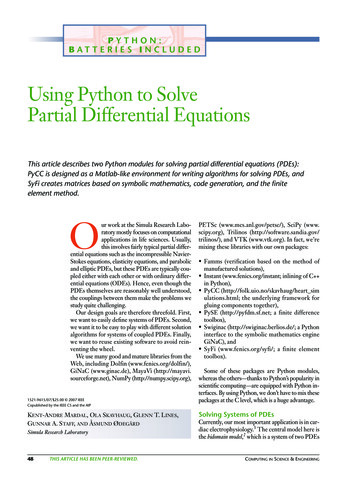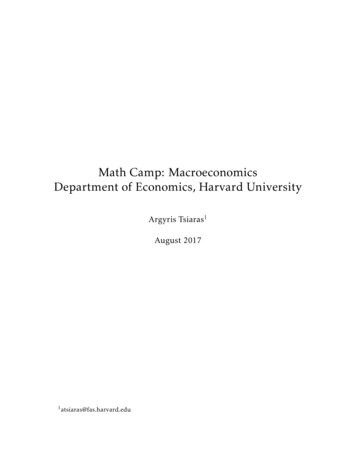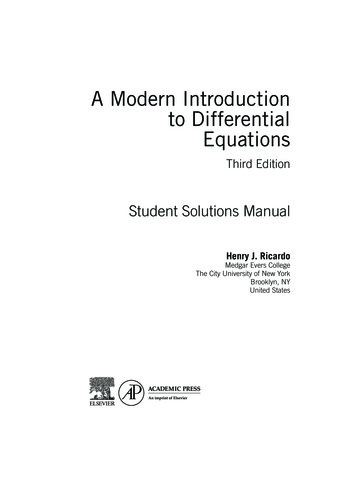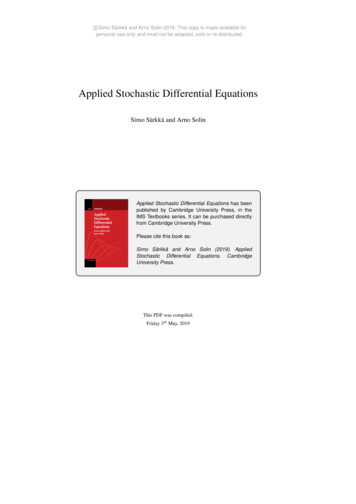
Transcription
c Simo Särkkä and Arno Solin 2019. This copy is made available forpersonal use only and must not be adapted, sold or re-distributed.Applied Stochastic Differential EquationsSimo Särkkä and Arno SolinApplied Stochastic Differential Equations has beenpublished by Cambridge University Press, in theIMS Textbooks series. It can be purchased directlyfrom Cambridge University Press.Please cite this book as:Simo Särkkä and Arno Solin (2019). AppliedStochastic Differential Equations. CambridgeUniversity Press.This PDF was compiled:Friday 3rd May, 2019
c Simo Särkkä and Arno Solin 2019. This copy is made available forpersonal use only and must not be adapted, sold or re-distributed.
c Simo Särkkä and Arno Solin 2019. This copy is made available forpersonal use only and must not be adapted, sold or 2.22.32.42.52.62.72.8Some Background on Ordinary Differential EquationsWhat Is an Ordinary Differential Equation?Solutions of Linear Time-Invariant Differential EquationsSolutions of General Linear Differential EquationsFourier TransformsLaplace TransformsNumerical Solutions of Differential EquationsPicard–Lindelöf Pragmatic Introduction to Stochastic Differential EquationsStochastic Processes in Physics, Engineering, and Other FieldsDifferential Equations with Driving White NoiseHeuristic Solutions of Linear SDEsHeuristic Solutions of Nonlinear SDEsThe Problem of Solution Existence and .64.7Itô Calculus and Stochastic Differential EquationsThe Stochastic Integral of ItôItô FormulaExplicit Solutions to Linear SDEsFinding Solutions to Nonlinear SDEsExistence and Uniqueness of SolutionsStratonovich CalculusExercises4242464952545556v
c Simo Särkkä and Arno Solin 2019. This copy is made available forpersonal use only and must not be adapted, sold or bability Distributions and Statistics of SDEsMartingale Properties and Generators of SDEsFokker–Planck–Kolmogorov EquationOperator Formulation of the FPK EquationMarkov Properties and Transition Densities of SDEsMeans and Covariances of SDEsHigher-Order Moments of 7Statistics of Linear Stochastic Differential EquationsMeans, Covariances, and Transition Densities of Linear SDEsLinear Time-Invariant SDEsMatrix Fraction DecompositionCovariance Functions of Linear SDEsSteady-State Solutions of Linear SDEsFourier Analysis of LTI 77.8Useful Theorems and Formulas for SDEsLamperti TransformConstructions of Brownian Motion and the Wiener MeasureGirsanov TheoremSome Intuition on the Girsanov TheoremDoob’s h-TransformPath IntegralsFeynman–Kac 38.48.58.68.78.88.9Numerical Simulation of SDEsTaylor Series of ODEsItô–Taylor Series–Based Strong Approximations of SDEsWeak Approximations of Itô–Taylor SeriesOrdinary Runge–Kutta MethodsStrong Stochastic Runge–Kutta MethodsWeak Stochastic Runge–Kutta MethodsStochastic Verlet AlgorithmExact .19.29.3Approximation of Nonlinear SDEsGaussian Assumed Density ApproximationsLinearized DiscretizationsLocal Linearization Methods of Ozaki and Shoji165165174175
c Simo Särkkä and Arno Solin 2019. This copy is made available forpersonal use only and must not be adapted, sold or re-distributed.Contentsvii9.49.59.69.79.89.9Taylor Series Expansions of Moment EquationsHermite Expansions of Transition DensitiesDiscretization of FPKSimulated Likelihood MethodsPathwise Series Expansions and the Wong–Zakai .410.510.610.710.810.910.10Filtering and Smoothing TheoryStatistical Inference on SDEsBatch Trajectory EstimatesKushner–Stratonovich and Zakai EquationsLinear and Extended Kalman–Bucy FilteringContinuous-Discrete Bayesian Filtering EquationsKalman FilteringApproximate Continuous-Discrete FilteringSmoothing in Continuous-Discrete and Continuous TimeApproximate Smoothing 3111Parameter Estimation in SDE Models11.1 Overview of Parameter Estimation Methods11.2 Computational Methods for Parameter Estimation11.3 Parameter Estimation in Linear SDE Models11.4 Approximated-Likelihood Methods11.5 Likelihood Methods for Indirectly Observed SDEs11.6 Expectation–Maximization, Variational Bayes, and OtherMethods11.7 Exercises23423423623924324612Stochastic Differential Equations in Machine Learning12.1 Gaussian Processes12.2 Gaussian Process Regression12.3 Converting between Covariance Functions and SDEs12.4 GP Regression via Kalman Filtering and Smoothing12.5 Spatiotemporal Gaussian Process Models12.6 Gaussian Process Approximation of Drift Functions12.7 SDEs with Gaussian Process Inputs12.8 Gaussian Process Approximation of SDE Solutions12.9 3.1 Overview of the Covered Topics13.2 Choice of SDE Solution Method277277278248249
c Simo Särkkä and Arno Solin 2019. This copy is made available forpersonal use only and must not be adapted, sold or re-distributed.viii13.3ContentsBeyond the TopicsReferencesSymbols and AbbreviationsList of ExamplesList of AlgorithmsIndex279281293305309311
c Simo Särkkä and Arno Solin 2019. This copy is made available forpersonal use only and must not be adapted, sold or re-distributed.PrefaceThis book is an outgrowth of a set of lecture notes that has been extendedwith material from the doctoral theses of both authors and with a largeamount of completely new material. The main motivation for the book isthe application of stochastic differential equations (SDEs) in domains suchas target tracking and medical technology and, in particular, their use inmethodologies such as filtering, smoothing, parameter estimation, and machine learning. We have also included a wide range of examples of applications of SDEs arising in physics and electrical engineering.Because we are motivated by applications, much more emphasis is puton solution methods than on analysis of the theoretical properties of equations. From the pedagogical point of view, one goal of this book is to provide an intuitive hands-on understanding of what SDEs are all about, and ifthe reader wishes to learn the formal theory later, she can read, for example,the brilliant books of Øksendal (2003) and Karatzas and Shreve (1991).Another pedagogical aim is to overcome a slight disadvantage in manySDE books (e.g., the aforementioned ones), which is that they lean heavilyon measure theory, rigorous probability theory, and the theory of martingales. There is nothing wrong in these theories – they are very powerfultheories and everyone should indeed master them. However, when thesetheories are explicitly used in explaining SDEs, they bring a flurry of technical details that tend to obscure the basic ideas and intuition for the firsttime reader. In this book, without shame, we trade rigor for readability bytreating SDEs completely without measure theory.The book’s low learning curve only assumes prior knowledge of ordinary differential equations and basic concepts of statistics, together withunderstanding of linear algebra, vector calculus, and Bayesian inference.The book is mainly intended for advanced undergraduate and graduatestudents in applied mathematics, signal processing, control engineering,ix
c Simo Särkkä and Arno Solin 2019. This copy is made available forpersonal use only and must not be adapted, sold or re-distributed.statistics, and computer science. However, the book is suitable also for researchers and practitioners who need a concise introduction to the topic ata level that enables them to implement or use the methods.The worked examples and numerical simulation studies in each chapterillustrate how the theory works in practice and can be implemented forsolving the problems. End-of-chapter exercises include application-drivenderivations and computational assignments. The M ATLAB R source codefor reproducing the example results is available for download through thebook’s web page, promoting hands-on work with the methods.We have attempted to write the book to be freestanding in the sensethat it can be read without consulting other material on the way. We havealso attempted to give pointers to work that either can be considered asthe original source of an idea or just contains more details on the topicat hand. However, this book is not a survey, but a textbook, and thereforewe have preferred citations that serve a pedagogical purpose, which mightnot always explicitly give credit to all or even the correct inventors of thetechnical ideas. Therefore, we need to apologize to any authors who havenot been cited although their work is clearly related to the topics that wecover. We hope you understand.The authors would like to thank Aalto University for providing thechance to write this book. We also would like to thank Robert Piché, PetteriPiiroinen, Roland Hostettler, Filip Tronarp, Santiago Cortés, Johan Westö,Joonas Govenius, Ángel García-Fernández, Toni Karvonen, Juha Sarmavuori, and Zheng Zhao for providing valuable comments on early versionsof the book.Simo and Arno
c Simo Särkkä and Arno Solin 2019. This copy is made available forpersonal use only and must not be adapted, sold or re-distributed.1IntroductionThe topic of this book is stochastic differential equations (SDEs). As theirname suggests, they really are differential equations that produce a different “answer” or solution trajectory each time they are solved. This peculiarbehaviour gives them properties that are useful in modeling of uncertainties in a wide range of applications, but at the same time it complicates therigorous mathematical treatment of SDEs.The emphasis of the book is on applied rather than theoretical aspects ofSDEs and, therefore, we have chosen to structure the book in a way that webelieve supports learning SDEs from an applied point of view. In the following, we briefly outline the purposes of each of the remaining chaptersand explain how the chapters are connected to each other. In the chapters,we have attempted to provide a wide selection of examples of the practicalapplication of theoretical and methodological results. Each chapter (exceptfor the Introduction and Epilogue) also contains a representative set of analytic and hands-on exercises that can be used for testing and deepeningunderstanding of the topics.Chapter 2 is a brief outline of concepts and solutions methods for deterministic ordinary differential equations (ODEs). We especially emphasizesolution methods for linear ODEs, because the methods translate quite easily to SDEs. We also examine commonly used numerical methods such asthe Euler method and Runge–Kutta methods, which we extend to SDEs inthe later chapters.Chapter 3 starts with a number of motivating examples of SDEs foundin physics, engineering, finance, and other applications. It turns out that ina modeling sense, SDEs can be regarded as noise-driven ODEs, but thisnotion should not be taken too far. The aim of the rest of the chapter is toshow where things start to go wrong. Roughly speaking, with linear SDEswe are quite safe with this kind of thinking, but anything beyond them willnot work.1
c Simo Särkkä and Arno Solin 2019. This copy is made available forpersonal use only and must not be adapted, sold or re-distributed.2IntroductionIn Chapter 4, we reformulate SDEs properly as stochastic integral equations where one of the terms contains a new kind of integral called the Itôintegral. We then derive the change of variable formula, that is, the Itô formula for the integral, and use it to find complete solutions to linear SDEs.We also discuss some methods to solve nonlinear SDEs and look briefly atStratonovich integrals.The aim of Chapter 5 is to analyze the statistics of SDEs as stochastic processes. We discuss and derive their generators, the Fokker–Planck–Kolmogorov equations, as well as Markov properties and transition densities of SDEs. We also derive the formal equations of the moments, such asthe mean and covariance, for the SDE solutions. It turns out, however, thatthese equations cannot easily be solved for other than linear SDEs. Thischallenge will be tackled later in the numerical methods chapters.As linear SDEs are very important in applications, we have dedicatedChapter 6 to solution methods for their statistics. Although explicit solutions to linear SDEs and general moment equations for SDEs were alreadygiven in Chapters 4 and 5, here we also discuss and derive explicit meanand covariance equations, transition densities, and matrix fraction methodsfor the numerical treatment of linear SDEs. We also discuss steady-statesolutions and Fourier analysis of linear time-invariant (LTI) SDEs as wellas temporal covariance functions of general linear SDEs.In Chapter 7, we discuss some useful theorems, formulas, and resultsthat are typically required in more advanced analysis of SDEs as well asin their numerical methods. In addition to the Lamperti transform, Girsanov theorem, and Doob’s h-transform, we also show how to find solutions to partial differential equations with Feynman–Kac formulas anddiscuss some connections to path integrals in physics. This chapter is notstrictly necessary for understanding the rest of the chapters and can beskipped during a first reading.Although the Itô stochastic calculus that is derivable from the Itô formula is theoretically enough for defining SDEs, it does not help much inpractical solution of nonlinear SDEs. In Chapter 8, we present numericalsimulation-based solution methods for SDEs. The methods are based primarily on Itô–Taylor series and stochastic Runge–Kutta methods, but wealso discuss the Verlet and exact algorithm methods.In many applications we are interested in the statistics of SDEs ratherthan their trajectories per se. In Chapter 9, we develop methods for approximate computation of statistics such as means and covariances or probability densities of SDEs – however, many of the methods are suitable for
c Simo Särkkä and Arno Solin 2019. This copy is made available forpersonal use only and must not be adapted, sold or re-distributed.Introduction3numerical simulation of SDEs as well. We start with classical and modern Gaussian “assumed density” approximations and then proceed to otherlinearization methods. We also discuss Taylor and Hermite series approximations of transition densities and their moments, numerical solutions ofFokker–Planck–Kolmogorov equations, simulation-based approximations,and finally pathwise Wong–Zakai approximations of SDEs.An important and historically one of the first applications of SDEs isthe filtering and smoothing theory. In Chapter 10, we describe the basicideas of filtering and smoothing and then proceed to the classical Kushner–Stratonovich and Zakai equations. We also present the linear and nonlinear Kalman–Bucy and Kalman filters and discuss their modern variants.Finally, we present formal equations and approximation methods for thecorresponding smoothing problems.The aim of Chapter 11 is to give an overview of parameter estimationmethods for SDEs. The emphasis is on statistical likelihood-based methodsthat aim at computing maximum likelihood (ML) or maximum a posteriori(MAP) estimates or are targeted to full Bayesian inference on the parameters. We start with brief descriptions of the ideas of ML and MAP estimatesas well as Markov chain Monte Carlo (MCMC) methods. Parameter estimation in linear SDEs is then discussed, and finally we give approximatelikelihood methods for parameter estimation in nonlinear SDEs. We alsodiscuss some parameter estimation methods for indirectly observed SDEs.Chapter 12 addresses the somewhat less traditional topic of connectionsbetween machine learning and SDEs. The aim is to discuss links betweenGaussian process regression, Kalman filtering, and SDEs, along with applications of the methods across the fields of signal processing and machinelearning.Finally, Chapter 13 concludes the book with an overview and givessome hints where to go next. We also discuss additional topics such asfractional Brownian motions, Lévy process driven SDEs, and stochasticcontrol problems.
c Simo Särkkä and Arno Solin 2019. This copy is made available forpersonal use only and must not be adapted, sold or re-distributed.2Some Background on Ordinary DifferentialEquationsThe chapter provides background on deterministic (nonstochastic) ordinary differential equations (ODEs) from points of view especially suitedto the context of stochastic differential equations (SDEs). As SDEs are inherently inhomogeneous differential equations (i.e., they have an input),we will concentrate on solution methods suitable for them. Furthermore,as linear and especially linear time-invariant (LTI) ODE systems are important in applications, we review the matrix exponential– and transitionmatrix–based methods of solution. We also discuss Fourier– and Laplacetransform–based solution methods for LTI ODEs and for computing matrixexponentials. For more details on ODE methods and theory, the reader isreferred to the books of Kreyszig (1993), Tenenbaum and Pollard (1985),and Hairer et al. (2008), although the same information can be found inmany other books as well.2.1 What Is an Ordinary Differential Equation?An ODE is an equation in which the unknown quantity is a function, andthe equation involves derivatives of the unknown function. For example,the second-order differential equation for a forced spring–mass system (or,e.g., a resonator circuit in telecommunications) can be generally expressedasd2 x.t/dx.t /CC 2 x.t / D w.t /;(2.1)dt 2dtwhere and are constants that determine the resonant angular velocityand damping of the spring. The force w.t / is some given function thatmay or may not depend on time. In this equation, the position variable x iscalled the dependent variable and time t is the independent variable. Theequation is of second order, because it contains the second derivative andno higher-order terms are present. It is linear, because x.t / appears linearly4
c Simo Särkkä and Arno Solin 2019. This copy is made available forpersonal use only and must not be adapted, sold or re-distributed.2.1 What Is an Ordinary Differential Equation?5in the equation. The equation is inhomogeneous, because it contains theforcing term w.t/. This inhomogeneous term will become essential in laterchapters, because replacing it with a random process leads to a stochasticdifferential equation.Here a solution to the differential equation is defined as a particularsolution, a function that satisfies the equation and does not contain any arbitrary constants. A general solution on the other hand contains every particular solution of the equation parameterized by some free constants. Toactually solve the differential equation, it is necessary to tie down the general solution by some initial conditions. In the preceding case, this meansthat we need to know the spring–mass position x.t / and velocity dx.t / dtat some fixed initial time t D t0 . Given these initial values, there is a uniquesolution to the equation (provided that w.t / is continuous). Instead of initial conditions, we could also fix some other (boundary) conditions of thedifferential equation to get a unique solution, but here we only considerdifferential equations with given initial conditions.Note that it is common not to write the dependencies of x and w on texplicitly, and write the equation asd2 xCdt 2dxC 2 x D w:dt(2.2)Although it sometimes is misleading, this “ink saving” notation is verycommonly used, and we will also employ it here whenever there is no riskof confusion. Furthermore, because in this section and in this whole bookwe mainly consider ordinary differential equations, we often drop the word“ordinary” and just talk about differential equations.Time derivatives are also sometimesdenoted with dots over the variable,ı 22such as xP D dx dt , xR D d x dt and so on. In this Newtonian notation,the previous differential equation would be written as(2.3)xR C xP C 2 x D w:Differential equations of an arbitrary order n can (almost) always beconverted into vector differential equations of order one. For example,in the preceding spring model, if we define a state variable x.t / D.x1 .t/; x2 .t// D .x.t/; dx.t/ dt /, we can rewrite the previous differential equation as a first-order vector differential equation: 01x1 .t /0dx1 .t/ dtDCw.t /:(2.4)2 x2 .t /1dx2 .t/ dt„ƒ‚ „ƒ‚ „ƒ‚ dx.t / dtf .x.t //L
c Simo Särkkä and Arno Solin 2019. This copy is made available forpersonal use only and must not be adapted, sold or re-distributed.6Some Background on Ordinary Differential EquationsThe preceding equation can be seen to be a special case of models of theformdx.t/D f .x.t /; t / C L.x.t /; t / w.t /;(2.5)dtwhere the vector-valued function x.t / 2 RD is generally called the stateof the system, f . ; / and L. ; / are arbitrary functions, and w.t / 2 RSis some (vector-valued) forcing function, driving function, or input to thesystem. Note that we can absorb the second term on the right into the firstterm to yielddx.t /D f .x.t /; t /;(2.6)dtand in that sense Equation (2.5) is slightly redundant. However, theform (2.5) turns out to be useful in the context of stochastic differentialequations, and thus it is useful to consider it explicitly.The first-order vector differential equation representation of an nth-orderdifferential equation is often called the state-space form of the differentialequation. Because nth order differential equations can (almost) always beconverted into equivalent n-dimensional vector-valued first-order differential equations, it is convenient to just consider such first-order equationsinstead of considering nth-order equations explicitly. Thus in this book,we develop the theory and solution methods (mainly) for first-order vectordifferential equations and assume that nth-order equations are always firstconverted into equations of this class.The spring–mass model in Equation (2.4) is also a special case of lineardifferential equations of the formdx.t/D F .t / x.t / C L.t / w.t /;(2.7)dtwhich is a very useful class of differential equations often arising in applications. The usefulness of linear equations is that we can actually solvethese equations, unlike general nonlinear differential equations. This kindof equations will be analyzed in the next sections.2.2 Solutions of Linear Time-Invariant Differential EquationsConsider the following scalar linear homogeneous differential equationwith a fixed initial condition at t D 0:dxD F x;x.0/ D given;(2.8)dt
c Simo Särkkä and Arno Solin 2019. This copy is made available forpersonal use only and must not be adapted, sold or re-distributed.2.2 Solutions of Linear Time-Invariant Differential Equations7where F is a constant. This equation can now be solved, for example, viaseparation of variables, which in this case means that we formally multiplyby dt and divide by x to yielddxD F dt:(2.9)xIf we now integrate the left-hand side from x.0/ to x.t / and right-hand sidefrom 0 to t, we getlog x.t/log x.0/ D F t;(2.10)which can be solved for x.t/ to give the final solution:x.t/ D exp.F t / x.0/:(2.11)Another way of arriving at the same solution is by integratingR t both sidesof the original differential equation from 0 to t. Because 0 dx dt dt Dx.t/ x.0/, we can express the solution x.t / asZ tx.t/ D x.0/ CF x. / d :(2.12)0We can now substitute the right-hand side of the equation for x. / insidethe integral, which gives Z t Z00x.t/ D x.0/ CF x.0/ CF x. / d d00 Z tZ t Z200D x.0/ C F x.0/d CF x. / d d000Z tZD x.0/ C F x.0/ t CF 2 x. 0 / d 0 d :(2.13)000Doing the same substitution for x. / inside the last integral further yields"#Z tZZ 0x.t/ D x.0/ C F x.0/ t CF 2 x.0/ CF x. 00 / d 00 d 0 d00D x.0/ C F x.0/ t C F 2 x.0/CZ tZ00ZZ tZ000d 0 d0F 3 x. 00 / d 00 d 0 d0t2D x.0/ C F x.0/ t C F x.0/ C22Z tZ00Z00F 3 x. 00 / d 00 d 0 d :(2.14)
c Simo Särkkä and Arno Solin 2019. This copy is made available forpersonal use only and must not be adapted, sold or re-distributed.8Some Background on Ordinary Differential EquationsIt is easy to see that repeating this procedure yields the solution of the formt3t2x.t/ D x.0/ C F x.0/ t C F 2 x.0/ C F 3 x.0/ C 26 F 2 t2F 3 t3D 1CF t CCC x.0/:(2.15)2Š3ŠThe series in the parentheses can be recognized to be the Taylor series forexp.F t/. Thus, provided that the series actually converges (it does), weagain arrive at the solutionx.t/ D exp.F t / x.0/:(2.16)The multidimensional generalization of the homogeneous linear differential equation (2.8) is an equation of the formdxD F x;x.0/ D given;(2.17)dtwhere F is a constant (i.e., time-independent) matrix. For this multidimensional equation, we cannot use the separation of variables method, becauseit only works for scalar equations. However, the series-based approachworks and yields a solution of the form F3 t3F2 t2CC x.0/:(2.18)x.t/ D I C F t C2Š3ŠThe series in the parentheses can now be seen as a matrix generalization ofthe exponential function. This series indeed is the definition of the matrixexponentialF3 t3F2 t2CC 2Š3Šand thus the solution to Equation (2.17) can be written asexp.F t/ D I C F t Cx.t/ D exp.F t / x.0/:(2.19)(2.20)Note that the matrix exponential cannot be computed by computing scalarexponentials of the individual elements in matrix F t . It is a completely different function. Sometimes the matrix exponential is written as expm.F t /to distinguish it from the elementwise computation, but here we use thecommon convention to simply write it as exp.F t /. The matrix exponentialfunction can be found as a built-in function in most commercial and opensource mathematical software packages such as M ATLAB R and Python. Inaddition to this kind of numerical solution, the exponential can be evaluated
c Simo Särkkä and Arno Solin 2019. This copy is made available forpersonal use only and must not be adapted, sold or re-distributed.2.2 Solutions of Linear Time-Invariant Differential Equations9analytically, for example, by directly using the Taylor series expansion, byusing the Laplace or Fourier transform, or via the Cayley–Hamilton theorem (Åström and Wittenmark, 1997).Example 2.1 (Matrix exponential). To illustrate the difference between thematrix exponential and the elementwise exponential, consider the equationd2 xD 0; x.0/ D given; . dx dt/.0/ D given;dt 2which in state-space form can be written as dx0 1Dx;x.0/ D given;0 0dt„ ƒ‚ (2.21)(2.22)Fwhere x D .x; dx dt/. Because F n D 0 for n 1, the matrix exponentialis simply 1 texp.F t/ D I C F t D(2.23)0 1which is completely different from the elementwise matrix exponential: 1 texp.0/ exp.t /1 et D:(2.24)0 1exp.0/ exp.0/1 1Let us now consider the following linear differential equation with aninhomogeneous term on the right-hand side:dx.t/D F x.t / C L w.t /;(2.25)dtwhere x.t0 / is given and the matrices F and L are constant. For inhomogeneous equations, the solution methods are numerous, especially if we donot want to restrict ourselves to specific kinds of forcing functions w.t /.However, the following integrating factor method can be used for solvinggeneral inhomogeneous equations.If we move the term F x.t/ in Equation (2.25) to the left-hand side andmultiply with a term called integrating factor exp. F t /, we get the following result:dx.t/exp. F t / F x.t / D exp. F t / L w.t /:(2.26)dtFrom the definition of the matrix exponential, we can derive the followingproperty:dŒexp. F t / D exp. F t / F :(2.27)dtexp. F t/
c Simo Särkkä and Arno Solin 2019. This copy is made available forpersonal use only and must not be adapted, sold or re-distributed.10Some Background on Ordinary Differential EquationsThe key thing is now to observe thatddx.t /Œexp. F t/ x.t/ D exp. F t /dtdtexp. F t / F x.t /;(2.28)which is exactly the left-hand side of Equation (2.26). Thus we can rewritethe equation asdŒexp. F t/ x.t / D exp. F t / L w.t /:dt(2.29)Integrating from t0 to t then givesexp. F t/ x.t/exp. F t0 / x.t0 / DZtexp. F / L w. / d ; (2.30)t0which can be further rearranged to give the final solutionZ tx.t/ D exp.F .t t0 // x.t0 / Cexp.F .t // L w. / d :(2.31)t0In the preceding solution, we have also used the identityexp.F s/ exp.F t/ D exp.F .s C t //, which is true because the matrices F s and F t commute. The expression (2.31) is the complete solutionto Equation (2.25).2.3 Solutions of General Linear Differential EquationsIn this section, we consider solutions to more general, time-varying lineardifferential equations. The corresponding stochastic equations are a usefulclass of equations, because they can be solved in (semi)closed form quiteanalogously to the deterministic case considered in this section.The solution presented in the previous section in terms of matrix exponential only works if the matrix F is constant. Thus for the time-varyinghomogeneous equation of the formdxD F .t / x;dtx.t0 / D given;(2.32)the matrix exponential solution does not work. However, we can expressthe solution in the formx.t/ D ‰.t; t0 / x.t0 /;(2.33)
c Simo Särkkä and Arno Solin 2019. This copy is made available forpersonal use only and must not be adapted, sold or re-distributed.2.4 Fourier Transforms11where ‰.t; t0 / is the transition matrix which is defined via the properties@‰. ; t/D F . / ‰. ; t /;@@‰. ; t/D ‰. ; t / F .t /;@t‰. ; t / D ‰. ; s/ ‰.s; t /;‰.t; / D ‰1(2.34). ; t /;‰.t; t/ D I:The transition matrix ‰.t; t0 / does not have a closed-form expression ingeneral. Nevertheless, given the transition matrix we can construct the solution to the inhomogeneous equationdxD F .t/ x C L.t / w.t /; x.t0 / D given;(2.35)dtanalogously to the ti
This PDF was compiled: Friday 3rd May, 2019. c Simo Särkkä and Arno Solin 2019. This copy is made available for . 4 Itô Calculus and Stochastic Differential Equations 42 4.1 The Stochastic Integral of Itô 42 . Chapter 2 is a brief outline of concepts and solutions methods for deter-ministic ordinary differential equations (ODEs). .

